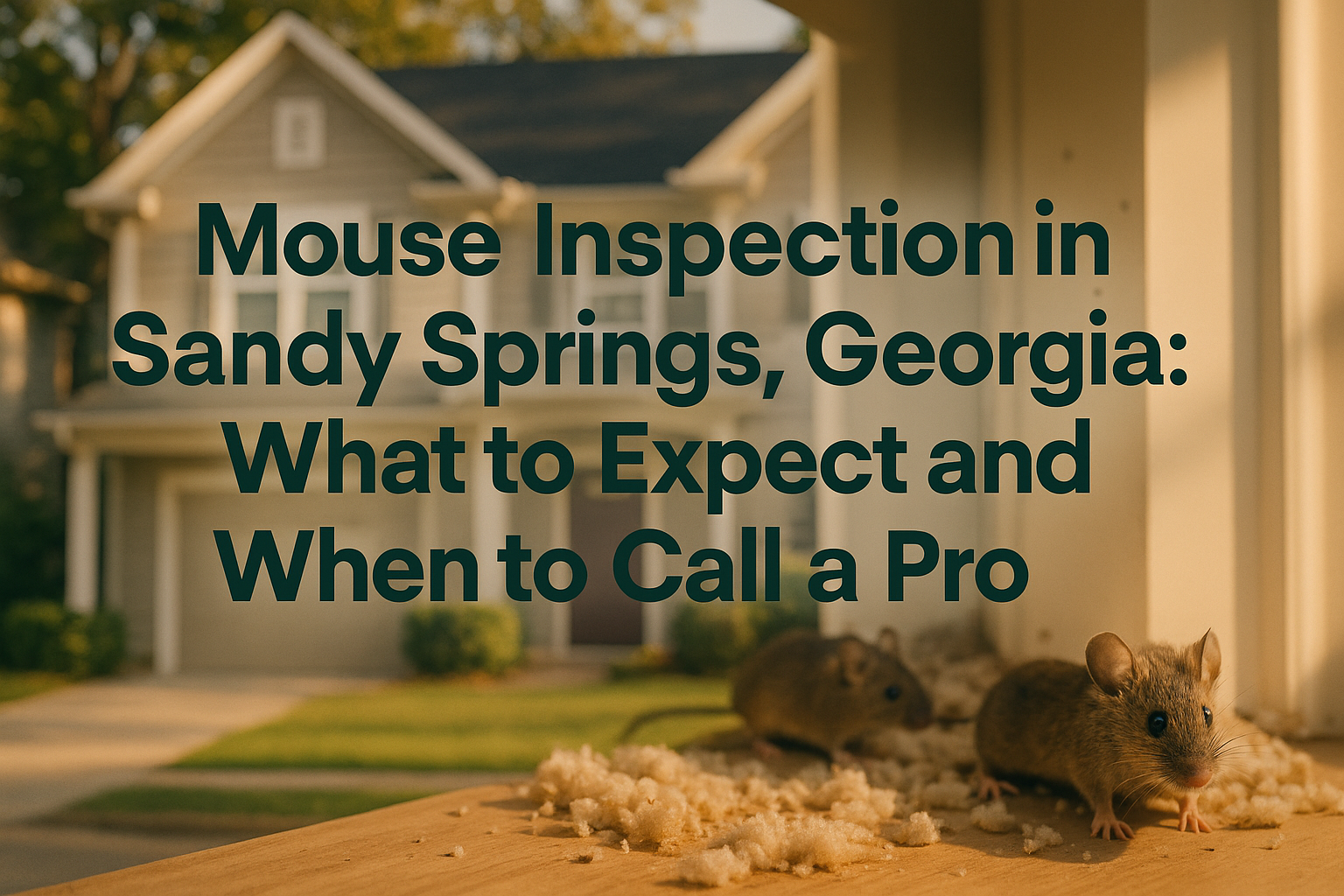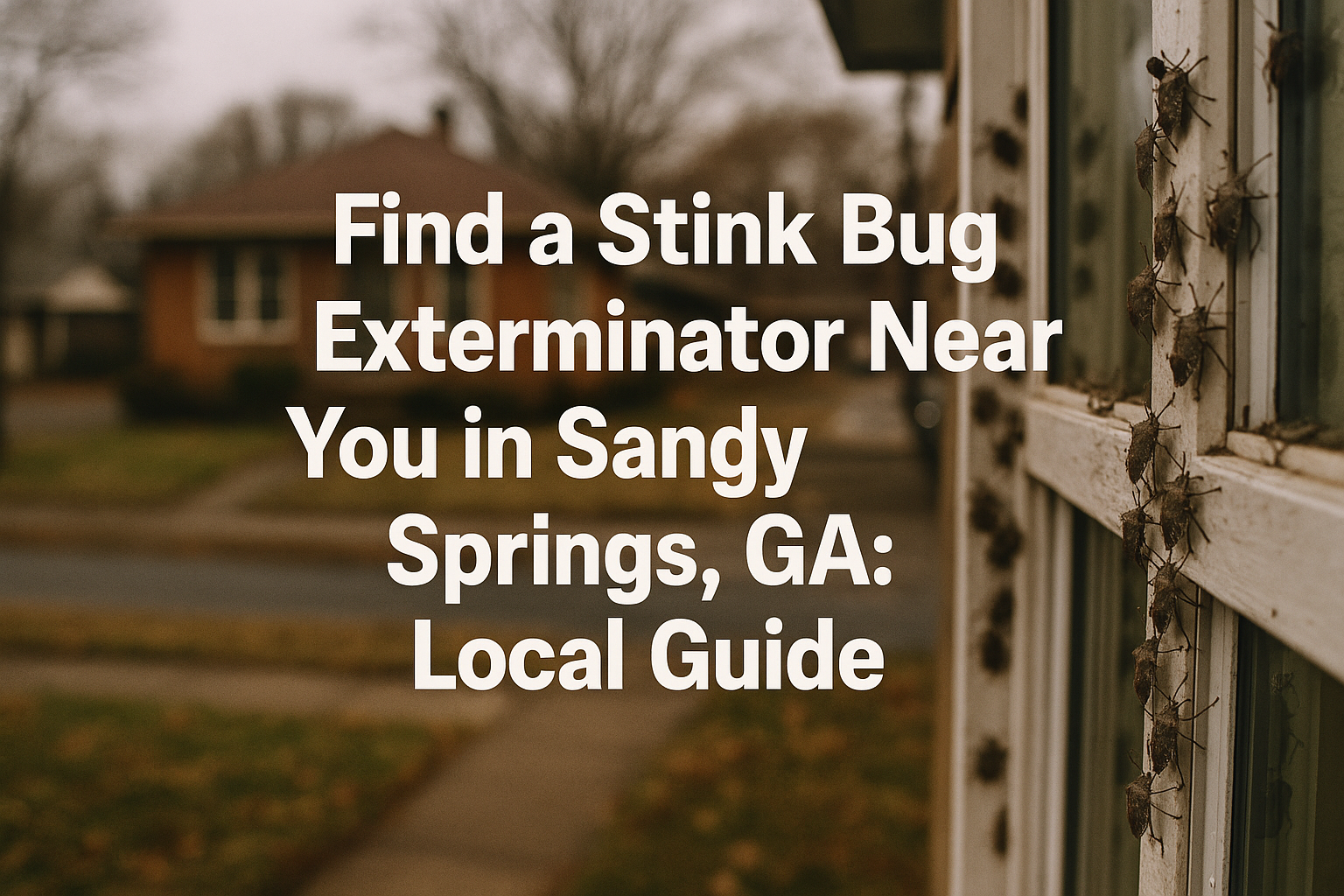Why Sandy Springs Homes Attract Mice—and Why Inspections Matter
If you’ve been hearing scratching in the walls or spotting those tiny droppings in the pantry, you’re not alone—mice are regular guests in Sandy Springs households. With all the lush green space around Riverside, the tree cover in the Dunwoody Panhandle, and the older yards in North Springs, it’s easy for rodents to sneak right up to your front door. That’s why scheduling a mouse inspection Sandy Springs GA homeowners can rely on is so important. Sandy Springs’ warm, humid weather gives them the perfect reason to stay comfy year-round—especially when cooler snaps send them searching for shelter.
Mice aren’t just a nuisance. They chew through everything from insulation to wires, tearing up your home little by little. Beyond the mess and the midnight pitter-patter, mice carry bacteria and can trigger allergies, putting your family’s health at risk. Even worse, ignoring the signs often means it’ll just get pricier and more stressful as time goes on.
Here’s something many folks don’t realize: getting a professional mouse inspection Sandy Springs GA homeowners often need typically falls between $125 and $250. Sure, it might sound like an extra expense, but it’s a drop in the bucket compared to what you could spend reversing the damage or chasing mice with endless store-bought traps. Local pros know how to spot the subtle clues that DIY methods miss—saving you time, money, and a lot of headaches down the road.
This article lays out what you need to know: your options for professional inspection, how pricing works, and the top ways to mouse-proof your Sandy Springs home. If you’re wondering when to call for help, or what inspection solutions work best in our neighborhoods, keep reading. Taking action early can mean the difference between a quick fix and an ongoing problem—protect your family and your investment by learning your options now.
What Really Decides the Cost of a Mouse Inspection in Sandy Springs?
If you’re pricing out a mouse inspection Sandy Springs GA service, you’ll see the numbers shift depending on a few key things about your home. First off, square footage matters—a cozy ranch takes a lot less time than a big place with multiple levels, a finished basement, or a spacious attic. Every nook, cranny, and crawlspace is another spot the pro has to check, so the bigger or more complex the house, the more time—and money—you’re looking at.
Then there’s how bad the mouse problem is. If you’ve just spotted a dropping or two, a basic checkup runs faster and uses fewer materials. But if you hear scratching in the walls at night or spot gnawed boxes around the pantry, you might be dealing with a full-blown invasion. Bluntly: more mice equals more hours, maybe more high-tech inspection tools, and likely repeat visits to be sure you’re in the clear.
Speaking of tools, the inspection method itself can move the price needle. Basic visual sweeps cost less, but if you need moisture or thermal scans to find hidden nests or tricky entry points, that’s specialized gear and extra expertise. The more in-depth the approach, the higher the investment up front—but it can save hassle on the fix.
Your neighborhood can matter too. In places like Huntcliff or Mount Vernon Woods, with older homes or big layouts, it’s tougher to check everywhere mice sneak in (and old houses love their secret holes). A detailed mouse inspection Sandy Springs GA service in these areas can cost a bit more than the average because there’s just more ground to cover and more oddball places to look.
- Basic inspection: $125–$250
- Detailed/large property inspection: $250–$400
- Bundled exclusion & treatment packages: $350 and up
Always ask for an itemized quote that spells out exactly what’s being checked and covered. Every house is different, and you want your inspection—and the price—to fit your exact situation.
What Really Decides the Cost of a Mouse Inspection in Sandy Springs?
If you’re pricing out a mouse inspection Sandy Springs GA homeowners often request, you’ll see the numbers shift depending on a few key things about your home. First off, square footage matters—a cozy ranch takes a lot less time than a big place with multiple levels, a finished basement, or a spacious attic. Every nook, cranny, and crawlspace is another spot the pro has to check, so the bigger or more complex the house, the more time—and money—you’re looking at.
Then there’s how bad the mouse problem is. If you’ve just spotted a dropping or two, a basic checkup runs faster and uses fewer materials. But if you hear scratching in the walls at night or spot gnawed boxes around the pantry, you might be dealing with a full-blown invasion. Bluntly: more mice equals more hours, maybe more high-tech inspection tools, and likely repeat visits to be sure you’re in the clear.
Speaking of tools, the inspection method itself can move the price needle. Basic visual sweeps cost less, but if you need moisture or thermal scans to find hidden nests or tricky entry points, that’s specialized gear and extra expertise. The more in-depth the approach, the higher the investment up front—but it can save hassle on the fix.
Your neighborhood can matter, too. In places like Huntcliff or Mount Vernon Woods, with older homes or big layouts, it’s tougher to check everywhere mice sneak in (and old houses love their secret holes). A thorough mouse inspection Sandy Springs GA homeowners schedule in these neighborhoods can cost a bit more than the average because there’s just more ground to cover and more oddball places to look.
- Basic inspection: $125–$250
- Detailed/large property inspection: $250–$400
- Bundled exclusion & treatment packages: $350 and up
Always ask for an itemized quote that spells out exactly what’s being checked and covered. Every house is different, and you want your inspection—and the price—to fit your exact situation.
Why Sandy Springs Homes Need Thorough Mouse Inspections
If you live in Sandy Springs, you know our weather keeps things interesting. That good old Georgia humidity and those rolling summer storms don’t just mess with cookouts—they send mice searching for dry, cozy shelter, and your house quickly becomes prime real estate. What many folks don’t realize is how our climate, our landscaping, and the way our homes are built can all make a big difference in how likely you are to deal with mice—and how tough (and costly) those problems might get.
Take neighborhoods like Riverside or Spalding Woods. Homes built before the 1980s often have crawlspaces with old metal or wood vents, tired siding, and those sneaky gaps hiding under the eaves. Over time, rain and ground shifting leave little cracks perfect for a mouse squeeze-through. If your house is shaded by mature trees, or sits near one of our creeks or streams, that shade and moisture gives rodents even more cover—and once they find an opening, they’re in.
It isn’t just about old versus new, either. Lots with thick shrubs, wood piles, or dense plantings right against the foundation practically roll out the welcome mat for mice. Brick homes offer a little better defense than wood, but even the toughest material can have weak spots as it settles and ages. Then there’s the home’s layout—split-levels and multi-story houses are more complex to inspect, with more corners and spaces to block off. Every bend or crawlspace adds time and labor to the job.
That’s why it pays to think ahead when booking your inspection and sealing work. The area’s climate, your home’s age, and even the way your property’s landscaped all play a part in what our techs look for—and how long the job might take. If your property matches any of the factors above, it’s wise to plan for a more detailed mouse inspection Sandy Springs GA residents can count on. Knowing what drives mouse problems in your part of Sandy Springs helps you avoid surprises when it comes to both solutions and costs. Check the next infographic for a quick visual breakdown of what to watch for around your own house.
Easy Ways to Keep Mice Out (And Save On Inspections)
If you want to avoid shelling out for big pest control bills, the best move is to make your home as uninviting as possible for mice. It starts with a few smart habits that make any inspection quicker—and maybe cheaper in the long run.
- Lock up food: Don’t give mice a reason to stick around. Keep all your food, pet food, and even that bag of bird seed in tightly sealed containers. Cardboard and thin plastic just won’t cut it against hungry rodents.
- Cut down hiding spots: Got piles of old boxes or random stuff in your attic, basement, or garage? Time for a tidy-up. Less clutter means fewer places for mice to make a home—and makes it easier for your technician to check for issues.
- Dry it out: Mice love a damp space. Fix any leaky pipes, clear out standing water, and use a dehumidifier if you have a musty crawlspace. The drier things are, the less appealing your home is to rodents.
- Curb appeal for you, not for mice: Keep shrubs trimmed, clear out leaves and yard debris, and don’t stack firewood right against the house. You’ll take away natural hiding spots and help your home inspector see entry points faster.
- Be a detective: Every season (especially before it gets cold), do a quick walkaround. Check for gaps, cracks, and broken weather stripping. If you can slide a pencil under a door or spot sunlight through a crack, it’s time to seal it up.
- Seal it tight: Small jobs—like adding weather stripping or patching little holes with steel wool and caulk—make a huge difference. You’re stopping mice at the door, which speeds up professional inspections and sometimes drops your service bill.
By building these habits, you make it tough for mice to bother you in the first place—and any pro that comes to check things out will have a much easier (and often quicker) job. That can mean faster visits, fewer surprises on your invoice, and a home you don’t have to stress about. Next up, let’s dig into which seasons call for extra attention and how timing your efforts pays off.
When’s the Right Time for a Mouse Inspection in Sandy Springs?
If you’ve ever caught noises in the attic or found stray droppings behind the fridge, timing your mouse inspection can make all the difference. In Sandy Springs, the best months to call a professional are late summer and early fall. As nights cool down, mice start looking for cozy places to nest—and that’s usually just before winter hits. Getting ahead of this pattern gives you the jump on them before they make your home their winter getaway.
Late summer and fall are sweet spots for a couple of reasons. First, you get more flexible appointment slots, so you don’t have to scramble to fit a rushed inspection into a packed family calendar. By the time winter rolls in, demand spikes—and so do prices. Having your inspection done in the fall often means more attractive rates and enough time to seal everything up before the first real cold snap.
Spring is another solid opportunity, especially once those chilly months are behind us. It’s a chance to see if any hardy mice made it through the winter and to check for new gaps, gnawed wires, or any damage you might have missed. Spring repairs and follow-up treatments keep things locked down before the next cycle starts.
If your house is close to the Chattahoochee River, a park, or any green space, you’ll want to be even more proactive in the late fall. Those areas are like magnets for rodents in search of food and shelter—and being ahead of the rush goes a long way.
Here’s the inside tip booking in advance isn’t just about beating the crowds. It also means you get more choice in scheduling and the breathing room to handle repairs or prevention steps at your own pace. Keep an eye out for the upcoming seasonal comparison to find the prime time for your next inspection. The right choice can save you time, stress, and a few chewed wires down the line.
Stop Mice Before They Take Over
Don’t wait for small mouse problems to turn into big headaches. If you’re in Sandy Springs, Anthem Pest Control is ready to help. Give us a call at 877-3718-5196 for your free, no-obligation inspection. Our local team will check every nook and cranny, answer your questions honestly, and show you exactly how affordable real protection can be. Get a custom prevention plan built for your home—so you can finally relax, knowing you’re ready for whatever the season brings. Your property and your peace of mind are just one call away.
Frequently Asked Questions About Mouse Inspections in Sandy Springs
- What signs should I look for before calling in a pro?
If you’re spotting little rice-shaped droppings, gnaw marks on food packaging or baseboards, shredded bits of paper or fabric hiding in corners, or notice your pets sniffing and pawing at the walls? Those are classic mouse red flags. A musty, lingering odor you can’t place could also mean you have uninvited guests. - How long does an inspection usually take?
Most mouse inspections wrap up within 1–2 hours. The size and layout of your home or business can make things quicker or a little slower, but pros work efficiently to cover all the nooks and crannies. - Will the inspection mess up my routine?
Not at all. Inspections are non-invasive and can be done around your schedule. You won’t need to move furniture or take the day off. Most folks are surprised at how smooth the process is. - How effective is doing my own inspection?
Checking for mice yourself can catch obvious stuff, but hidden trouble often goes unnoticed without the experience and gear the pros bring. If you want real peace of mind, professional eyes are your best bet. - How often should I get my property checked for mice?
At least once a year is smart for Sandy Springs homes and businesses—more often if you’ve had repairs, big cleanouts, or spotted activity. After any major pest incident, book another check just to be safe. - What happens if mice are found during inspection?
You’ll get a detailed rundown of what was found and where. Most services provide a game plan for removal and tips to keep mice from coming back. They’ll walk you through every step, no surprises. - Are rodent droppings really dangerous?
Unfortunately, yes. Certain diseases can be spread when droppings are handled without protection. If you find them, skip the clean-up and call your pro. Your safety comes first. - Does the inspection include sealing up entry points?
Lots of providers handle basic exclusion work, like sealing small gaps right away. For extensive animal-proofing, just double-check your specific package or ask the technician—they’ll be happy to explain what’s included.
Still have questions? Don’t hesitate to reach out. A quick call could save you time, stress, and a whole lot of hassle down the road!












